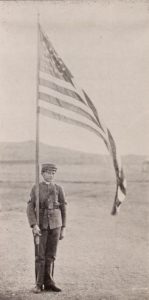In the nineteenth century Colorado established industrial schools for girls and boys who were in trouble. A State Industrial School was established in 1881 for boys ages 7-16 who were convicted of crimes. A few years later, it became apparent that such a school was needed for girls as well, and the State Home and Industrial School for Girls was established by state statute in 1887. The girls’ school took in “wayward” females up to age 18 who were convicted of crimes; pregnant; or arrested for “habitually wandering about the streets…at unseemly or improper hours.” If the girl was found to be without a proper home, or “is growing up in habits of vice or immorality,” the girl would be committed to the school for not less than nine months. Girls with no place to go could also apply to live at the school voluntarily. Babies delivered at the school were put up for adoption.
Both schools were located in Jefferson County. The military-style boys’ school put youngsters to work learning farming, masonry, blacksmithing, printing, woodworking, tailoring, and other industrious tasks that would allow them to learn a trade and make a living off of the streets. The girls, on the other hand, learned the domestic arts at their school, preparing them either to run a household or to enter into domestic service.
Biennial reports of the schools for selected years from the 1890s to the 1940s are available from our library and can be viewed online. They provide a fascinating picture of the lives of juvenile corrections inmates, including what they studied and, in some cases, what they wore and ate. The reports feature statistical and financial information on the school, as well as numerous photographs. The boys’ school even printed the reports in their print shop. These reports are valuable resources for any researcher studying the Progressive era in Colorado and the institutions of the late nineteenth and early twentieth centuries.

- How to Spot the Differences Between Eagles and Hawks - August 16, 2021
- How Transportation Projects Help Tell the Story of Colorado’s Past - August 9, 2021
- Time Machine Tuesday: The Night the Castlewood Canyon Dam Gave Way - August 3, 2021